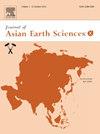Differential diagenetic and densification processes of low-permeability and tight sandstones: A case study of the Jurassic Shaximiao Formation in the central and western Sichuan Basin, China
IF 2.3
Q3 GEOSCIENCES, MULTIDISCIPLINARY
引用次数: 0
Abstract
Tight sandstone reservoirs of low permeability are of both scientific and economic significance, but their origin and formation process remain not well understood.. In this paper, we present a comprehensive study of the tight sandstone reservoir of the Middle Jurassic Shaximiao Formation distributed in central and western Sichuan Basin, by integrating scanning electron microscopy, X-ray diffraction, high-pressure mercury injection, and nuclear magnetic resonance. The aim of this study was to investigate the differential diagenetic sequences constrained by quantifying the provenance of the sandstones and densification processes. Overall, the Shaximiao Formation sandstones have low porosity of 0.46 %–18.76 % (averaging 10.17 %) and low permeability ranging from 0.0003 to 632.42 × 10−3 μm2 (averaging 3.67 × 10−3 μm2), with 73.72 % being classified as tight reservoirs. The sandstone samples from the western Sichuan Basin commonly display tubular or needle-shaped throats with less developed microfractures, consequently having weaker seepage capacity compared to the varieties in the central Sichuan Basin that are characterized by abundant lamellar and necked throats. The results suggest that the slightly lower contents of rigid particles and higher contents of fragments and argillaceous matrix facilitated continuous compaction and multitype cementation processes. Meanwhile, strong compaction of the rocks with cements of carbonate, siliceous materials, and laumontite being the cement lead to porosity reduction of 29.8 %, 12.27 %, 13.34 %, and 12.33 %, respectively. In contrast, chlorite coating and dissolution events have crucial roles in preserving pores and enhancing permeability.
低渗透致密砂岩差异成岩致密化过程——以四川盆地中西部侏罗系沙溪庙组为例
低渗透致密砂岩储层具有重要的科学和经济意义,但其成因和形成过程仍不清楚。采用扫描电镜、x射线衍射、高压压汞、核磁共振等综合手段,对分布在四川盆地中西部的中侏罗统沙溪庙组致密砂岩储层进行了综合研究。通过对砂岩物源和致密化过程的定量分析,探讨了该区的差异成岩序列。总体而言,沙溪庙组砂岩孔隙度为0.46% ~ 18.76%(平均10.17%),渗透率为0.0003 ~ 632.42 × 10−3 μm2(平均3.67 × 10−3 μm2),其中73.72%为致密储层。川西地区砂岩样品普遍呈管状或针状喉道,微裂缝发育程度较低,与川中地区片状和颈状喉道丰富的砂岩样品相比,渗流能力较弱。结果表明,较低的刚性颗粒含量和较高的破碎粒和泥质基质含量有利于连续压实和多类型胶结过程。同时,以碳酸盐胶结物、硅质胶结物和烟云母胶结物为胶结物的强压实作用使孔隙度分别降低29.8%、12.27%、13.34%和12.33%。相比之下,绿泥石包覆和溶蚀事件在保持孔隙和增强渗透性方面起着至关重要的作用。
本文章由计算机程序翻译,如有差异,请以英文原文为准。
求助全文
约1分钟内获得全文
求助全文
来源期刊

Journal of Asian Earth Sciences: X
Earth and Planetary Sciences-Earth-Surface Processes
CiteScore
3.40
自引率
0.00%
发文量
53
审稿时长
28 weeks
 求助内容:
求助内容: 应助结果提醒方式:
应助结果提醒方式:


